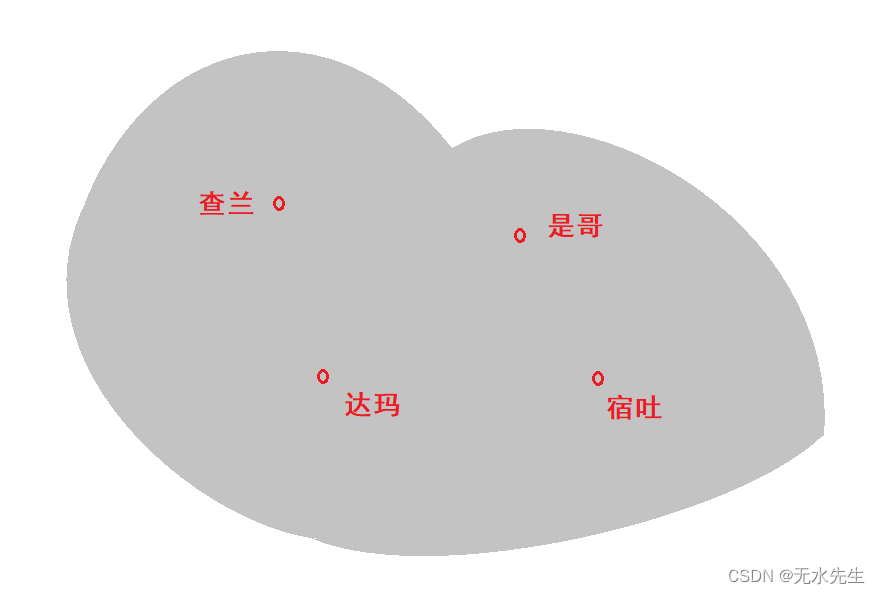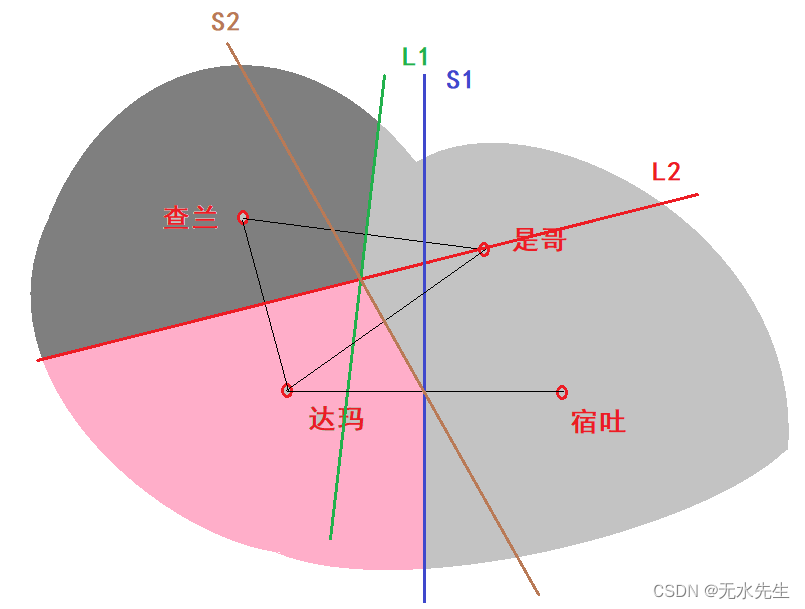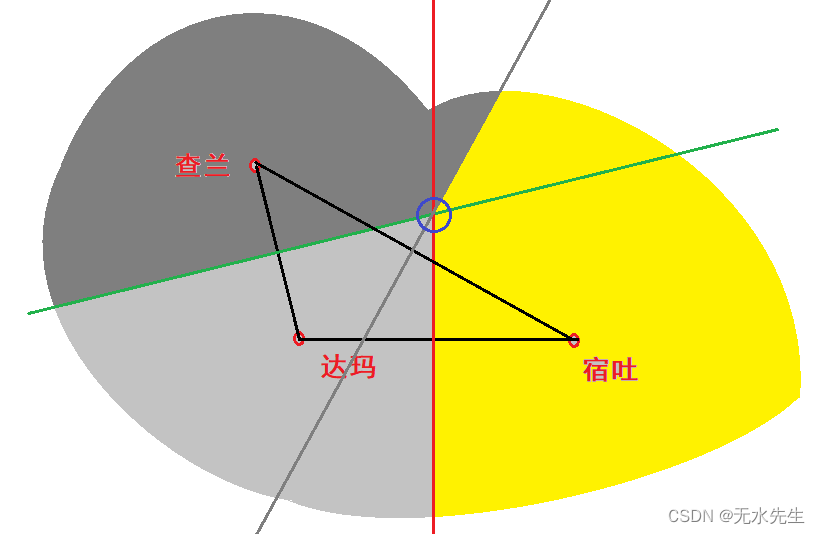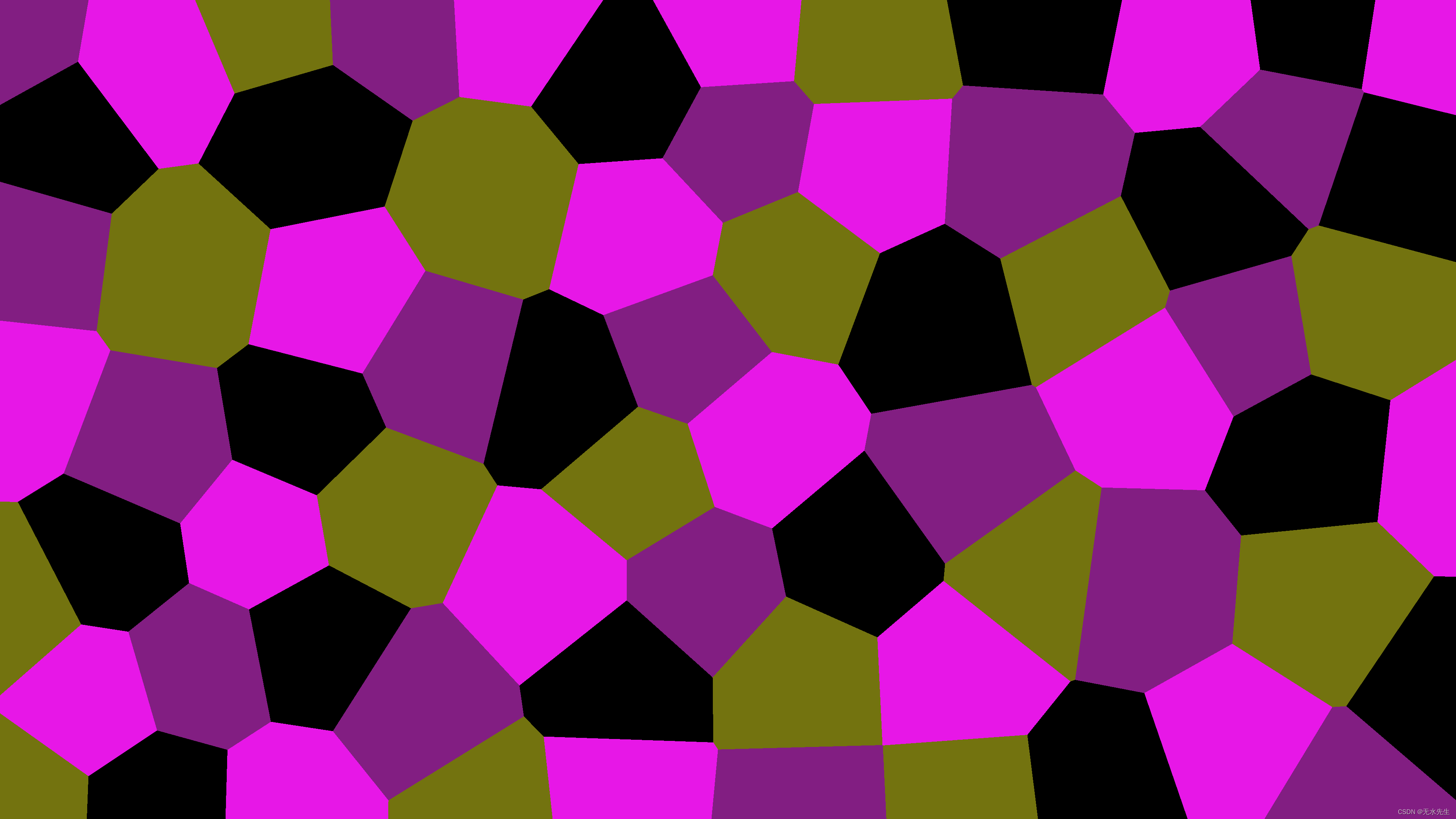目录
一、说明
二、帝国边界划分问题
三、voronoi的正规定义
3.1 最简单的voronoi情况
3.2 在距离空间的数学描述
3.3 不同距离空间所得 Voronoi 单元不同
四、代码和库
4.1 算法库
4.2 参数说明
4.3 调用方法
五、后记
一、说明
Voronoi 单元也称为泰森多边形。 Voronoi 图在许多领域都有实际和理论应用,主要是在科学和技术领域,但也在视觉艺术领域使用。Voronoi 图以数学家 Georgy Voronoy 的名字命名,也称为 Voronoi 镶嵌、Voronoi 分解、Voronoi 分区或 Dirichlet 镶嵌(以 Peter Gustav Lejeune Dirichlet 命名)。
在数学中,Voronoi 图是将对平面(集合)划分为多个区域的算法。在最简单的情况下,这些对象只是平面上的有限多个点(称为种子、站点或生成器)。对于每个种子,都有一个对应的优先划分区域。这种区域称为 Voronoi 单元,由平面上离该种子比其他任何点更近的所有点组成。一组点的 Voronoi 图与该组的 Delaunay 三角剖分是对偶的。
注意:点、区域、边界线成为这个算法的关键要素。
二、帝国边界划分问题
我们用一个童话故事构成思想实验。
话说,哈里发国王年事已高,厌倦朝政,因而计划将他的王国分为四份,分别由四个王子管理。于是召来宰相易普拉辛,说到:“我亲爱的宰相,我打算将王国分成四个部落,分别交给王子们统辖,如今有四个城池,分别是查兰,是哥,达玛,宿吐作为它们的都城,可是如何划分疆土我毫无主张,是真主启发我召你商议此事。”宰相思索片刻,说到:“赞美安拉,我倒是有一个谋划,请借地图叙述”,国王当即请出地图如下:

且看宰相如何划分国土。首先,确定查兰的边疆,如下:
1)从查兰引出两个线段,分别连接(是哥,达玛)因为宿土与查兰不接壤,所以不必引进宿土。
2)分别作出两条线段的垂直中分线。

做出两条中分线L1,L2。中分线上的特征是:L1线上点到查兰的距离一定等于该点到是哥距离,L2上的任意点到查兰距离,一定等于它到达玛的距离。因此,站在平分线上看两国首都,谁也没“侵犯”谁。故绿线和红线都是“公平线”,就此,查兰的土地被公平线L1和L2包络,已经画出。
3)接着划分达玛:从达玛引出线段,连接宿土和是哥,作公平线S1,和S2,这样达玛土地在公平线L2,S1,S1包围下也能画出,如图粉色区域。

显然,图中新增出粉色区域中,任意一点到达玛距离比到其它三城距离更近,保证达玛没有“侵犯”其它邻国。至此,达玛的边界因L2,S1,S2包络而确定。
注意: 虽然有公平线L1横穿达玛,但此线是【查兰,是哥】的公平线,与达玛无关。
4)最后,从宿土到是哥引出线段,并做出中分线T ,如图:

至此,宿土的边疆也因T-S2-L1包络出是哥的领土,至此国土划分完成。
哈里发看了宰相的划分,依然不悦,对宰相说到:“依照爱卿的划分,国土面积不等,如何说服四位王子服从分配?”宰相说到:“安啦是唯一的主,不妨把命运交给安拉,让他们抓阄分配”,国王听后,大喜曰:“然”。
提示:有个三线交于一点的问题,如L1-L2-S2三线交于一点,T-S1-S2三线相交。这需要证明。
三条线共交于一点的说明:在相邻三城边界划分中,每三个中分线是共点的,如下证明:

先假定篮圈内三线不相交,从角的垂线定律说明,红蓝角+红黑角+黑绿角=180度,因此三线必然共点。
或者说,三个点组成三角形,其外接圆圆心引出三条到边的垂线,这三条垂线正好等分三边。
三、voronoi的正规定义
3.1 最简单的voronoi情况
在最简单的情况下,如第一张图片所示,我们在欧几里得平面中得到一组有限的点 {p1, ..., pn}。在这种情况下,每个站点 pk 只是一个点,其对应的 Voronoi 单元 Rk 由欧几里得平面中的每个点组成,这些点到 pk 的距离小于或等于它到任何其他 pk 的距离。每个这样的单元都是从半空间的交集获得的,因此它是一个(凸)多面体。 [6] Voronoi 图的线段是平面上与最近的两个站点等距的所有点。 Voronoi 顶点(节点)是与三个(或更多)站点等距的点。

3.2 在距离空间的数学描述
下文中:生成点==站点
设X是一个距离函数的度量空间,K是一组索引, 是空间中非空子集(站点)的元组(索引集合)
是空间中非空子集(站点)的元组(索引集合) 。 Voronoi 单元或 Voronoi 区域,
。 Voronoi 单元或 Voronoi 区域, ,与网站相关
,与网站相关 是所有点的集合
是所有点的集合 距离
距离 不大于它们到其他站点的距离
不大于它们到其他站点的距离 ,其中
,其中 是任何不同于
是任何不同于 。换句话说,如果
。换句话说,如果 , 表示点与集合之间的距离(
, 表示点与集合之间的距离( 和子集
和子集 ),然后有:
),然后有:

Voronoi 图只是单元格的元组 。原则上,一些站点可以相交甚至重合(下面描述了代表商店的站点的应用程序),但通常假定它们是不相交的。此外,定义中允许有无限多个站点(此设置在数字几何和晶体学中有应用),但同样,在许多情况下,只考虑有限多个站点。
。原则上,一些站点可以相交甚至重合(下面描述了代表商店的站点的应用程序),但通常假定它们是不相交的。此外,定义中允许有无限多个站点(此设置在数字几何和晶体学中有应用),但同样,在许多情况下,只考虑有限多个站点。
在空间是有限维欧几里德空间的特殊情况下,每个站点都是一个点,有有限多个点并且所有点都不同,那么 Voronoi 单元是凸多边形,它们可以用组合方式表示它们的顶点、边、二维面等。有时,导出的组合结构被称为 Voronoi 图。然而,一般而言,Voronoi 单元可能不是凸的,甚至可能不是连接的。在通常的欧几里德空间中,我们可以用通常的术语重写形式定义。每个 Voronoi 多边形 与生成点相关联
与生成点相关联 。假定
。假定 是欧氏空间中所有点的集合。且
是欧氏空间中所有点的集合。且 是生成其 Voronoi 区域的
是生成其 Voronoi 区域的 的点,
的点, 生成2个
生成2个 , 和3个
, 和3个 生成3个
生成3个 等等。然后,Voronoi 多边形中的所有位置都比欧几里得平面中的 Voronoi 图中的任何其他生成点更接近该多边形的生成点”。
等等。然后,Voronoi 多边形中的所有位置都比欧几里得平面中的 Voronoi 图中的任何其他生成点更接近该多边形的生成点”。
3.3 不同距离空间所得 Voronoi 单元不同
如图,下面是基于欧氏空间和曼哈顿空间的划分:


以上就是欧氏空间和曼哈顿空间的划分细节。
四、代码和库
4.1 算法库
以下给出算法库Voronoi,是通过python写的代码
from PIL import Image, ImageColor, ImageDraw
from random import randint, choice, random, seed as randomseed
from typing import *
from math import hypot, sqrt
from queue import Queue
from dataclasses import dataclass
from enum import Enum
import os
import sys
class ColorAlgorithm(Enum):
random = 1
no_adjacent_same = 2
least_possible = 3
class RegionAlgorithm:
def randomized(width: int, height: int, regions: int, mask_function) -> List[Tuple[int, int]]:
"""Return regions that are entirely random."""
points = []
while len(points) != regions:
p = (randint(0, width - 1), randint(0, height - 1))
if p in points:
continue
if not mask_function(p):
continue
points.append(p)
return points
def uniform(width: int, height: int, regions: int, mask_function) -> List[Tuple[int, int]]:
"""Return regions that attempt to be somewhat uniform."""
k = 10
points = []
while len(points) != regions:
best_p = None
d_max = 0
i = 0
while i < k * len(points) + 1:
p = (randint(0, width - 1), randint(0, height - 1))
if p in points:
continue
if not mask_function(p):
continue
if len(points) == 0:
best_p = p
break
d_min = float('inf')
for x, y in points:
d = hypot(p[0]-x, p[1]-y)
if d < d_min:
d_min = d
if d_min > d_max:
d_max = d_min
best_p = p
i += 1
points.append(best_p)
return points
class DistanceAlgorithm:
def euclidean(x, y, xn, yn):
"""Calculate the image regions (up to a distance) using euclidean distance."""
return hypot(xn-x, yn-y)
def manhattan(x, y, xn, yn):
"""Calculate the image regions using manhattan distance."""
return abs(xn-x) + abs(yn-y)
def euclidean45degrees(x, y, xn, yn):
"""Calculate the image regions using euclidean, but allow only lines in 45 degree increments."""
return sqrt(2 * min(abs(xn-x), abs(yn-y)) ** 2) + abs(abs(xn-x) - abs(yn-y))
def chebyshev(x, y, xn, yn):
"""Calculate the image regions using chebyshev distance."""
return min(abs(xn-x), abs(yn-y)) + abs(abs(xn-x) - abs(yn-y))
def set_each_point(seed: int, width: int, height: int,
region_centers: List[Tuple[int, int]], image: List[List[int]],
d_limit: int, f: List[Callable[[int, int, int, int], float]], mask_function):
"""Calculate the image regions (up to a distance) using the provided metric."""
randomseed(seed)
region_distance_functions = [f if not isinstance(f, list) else choice(f) for _ in range(len(region_centers))]
for x in range(width):
for y in range(height):
if not mask_function((x, y)):
continue
d_min = float('inf')
for i, region in enumerate(region_centers):
xn, yn = region
d = region_distance_functions[i](x, y, xn, yn)
if d < d_min:
d_min = d
if d <= d_limit:
image[x][y] = id(region)
class Utilities:
def error(message, q=True):
print(f"\u001b[38;5;1mERROR:\u001b[0m {message}", flush=True)
if q:
sys.exit(1)
def warning(message):
print(f"\u001b[38;5;208mWARNING:\u001b[0m {message}", flush=True)
def info(message):
print(f"\u001b[38;5;11mINFO:\u001b[0m {message}", flush=True)
def success(message):
print(f"\u001b[38;5;2mSUCCESS:\u001b[0m {message}", flush=True)
def hex_to_tuple(color: str):
color = color.strip("#")
return (int(color[0:2], 16), int(color[2:4], 16), int(color[4:6], 16))
def get_different_adjacent_colors(width, height, image, colors, color_algorithm):
from pulp import LpProblem, LpVariable, LpMinimize, lpSum, PULP_CBC_CMD
edges = set()
mapping = {}
n = 0
for x in range(width):
for y in range(height):
for xd, yd in ((0, 1), (1, 0), (-1, 0), (0, -1)):
xn, yn = x + xd, y + yd
if not 0 <= xn < width or not 0 <= yn < height:
continue
i1, i2 = image[x][y], image[xn][yn]
if i1 is None or i2 is None:
continue
if i1 < i2:
if i1 not in mapping:
n += 1
mapping[n] = i1
mapping[i1] = n
if i2 not in mapping:
n += 1
mapping[n] = i2
mapping[i2] = n
edges.add((mapping[i1], mapping[i2]))
edges = list(edges)
model = LpProblem(sense=LpMinimize)
chromatic_number = LpVariable(name="chromatic number", cat='Integer')
variables = [[LpVariable(name=f"x_{i}_{j}", cat='Binary') \
for i in range(n)] for j in range(n)]
for i in range(n):
model += lpSum(variables[i]) == 1
for u, v in edges:
for color in range(n):
model += variables[u - 1][color] + variables[v - 1][color] <= 1
for i in range(n):
for j in range(n):
model += chromatic_number >= (j + 1) * variables[i][j]
if color_algorithm == ColorAlgorithm.least_possible:
model += chromatic_number
else:
model += chromatic_number == len(colors)
status = model.solve(PULP_CBC_CMD(msg=False))
if chromatic_number.value() > len(colors):
Utilities.error("Not enough colors to color without adjacent areas having the same one!")
return {mapping[variable + 1]: colors[color]
for variable in range(n)
for color in range(n)
if variables[variable][color].value() == 1}
def add_border(background, border_size, read_image, write_image, width, height, mask_function):
r = border_size // 2
for x in range(width):
for y in range(height):
if not mask_function((x, y)):
continue
for dx, dy in ((0, 1), (1, 0)):
xn, yn = x + dx, y + dy
if not 0 <= xn < width or not 0 <= yn < height:
continue
if not mask_function((xn, yn)):
continue
if read_image[x][y] != read_image[xn][yn]:
draw = ImageDraw.Draw(write_image)
draw.ellipse((x-r, y-r, x+r, y+r), fill=(*background,0))
def generate(
path: str,
regions: int,
colors: List[Union[Tuple[int], str]],
width: int = 1920,
height: int = 1080,
region_algorithm = RegionAlgorithm.uniform,
distance_algorithm = DistanceAlgorithm.euclidean,
color_algorithm = ColorAlgorithm.random,
seed: Optional[int] = None,
border_size: int = 0,
mask: Optional[str] = None,
mask_color = "#000000",
animate = False,
background = "#FFFFFF",
):
# possibly seed the random algorithm
if seed is None:
seed = random()
# possibly convert string colors to tuples
i = 0
while i < len(colors):
if type(colors[i]) == str:
colors[i] = Utilities.hex_to_tuple(colors[i])
i += 1
if type(mask_color) == str:
mask_color = Utilities.hex_to_tuple(mask_color)
elif type(mask_color) == list:
mask_color = tuple(mask_color)
if type(background) == str:
background = Utilities.hex_to_tuple(background)
elif type(background) == list:
background = tuple(background)
randomseed(seed)
mask_function = lambda p: True
if mask is not None:
try:
mask_img = Image.open(mask)
Utilities.info("Mask provided.")
w, h = mask_img.size
mask_function = lambda p: mask_img.getpixel(p) == mask_color
if w != width:
Utilities.warning("Specified width doesn't match mask width, using mask width.")
width = w
if h != height:
Utilities.warning("Specified height doesn't match mask height, using mask width.")
height = h
except Exception as e:
Utilities.error(f"Error loading mask from '{mask}'.")
if type(regions) == list:
Utilities.info("Region centers provided, skipping generation.")
# flip vertically!
region_centers = [(int(center[0] * width), int(height - center[1] * height)) for center in regions]
else:
Utilities.info("Calculating region centers.")
region_centers = region_algorithm(width, height, regions, mask_function)
image = [[None] * height for _ in range(width)]
Utilities.info("Calculating region areas.")
DistanceAlgorithm.set_each_point(seed, width, height, region_centers, image, float("inf"), distance_algorithm, mask_function)
# either assign colors randomly, or calculate the chromatic number and assign them then
if color_algorithm == ColorAlgorithm.random:
Utilities.info("Assigning region colors.")
region_colors = {id(region): choice(colors) for region in region_centers}
else:
Utilities.info("Assigning region colors such that no two adjacent regions have the same color.")
region_colors = Utilities.get_different_adjacent_colors(width, height, image, colors, color_algorithm)
# if we're masking, some regions won't be assigned
region_colors[None] = background
# the original, full image (without borders)
pil_image = Image.new("RGB", (width, height))
for x in range(width):
for y in range(height):
pil_image.putpixel((x, y), region_colors[image[x][y]])
if border_size != 0:
Utilities.add_border(background, border_size, image, pil_image, width, height, mask_function)
if animate:
if not os.path.exists(path):
os.makedirs(path)
d = 1
while True:
animation_image = [[None] * height for _ in range(width)]
DistanceAlgorithm.set_each_point(seed, width, height, region_centers, animation_image, d, distance_algorithm, mask_function)
animation_pil_image = Image.new("RGB", (width, height))
for x in range(width):
for y in range(height):
animation_pil_image.putpixel((x, y), background if animation_image[x][y] is None else region_colors[image[x][y]])
if border_size != 0:
Utilities.add_border(background, border_size, animation_image, animation_pil_image, width, height)
animation_path = os.path.join(path, f"{d}.png")
animation_pil_image.save(animation_path, "PNG")
Utilities.success(f"Animation image saved to {animation_path}")
d += 1
if image == animation_image:
Utilities.success(f"Done!")
break
else:
pil_image.save(path, resolution=300)
Utilities.success(f"Image saved to {path}!")
4.2 参数说明
generate function arguments
path: the path (including an extension) to save the resulting file toregions: the number of distinct regions in the diagramcolors: a list of tuples denoting the RGB of the color, or strings denoting the color in hexwidth: the width of the image; defaults to 1920height: the height of the image; defaults to 1080region_algorithm: the algorithm that determines the centers of the regions:
RegionAlgorithm.uniform attempts to make the centers equidistant to one another; defaultRegionAlgorithm.randomized makes the center positions entirely random
distance_algorithm: the algorithm that determines the way the distance is measured; if a list of the algorithms is provided, a random one is picked for each point
DistanceAlgorithm.euclidean: standard euclidean distance (hypotenuse); defaultDistanceAlgorithm.manhattan: Manhattan (taxicab) distance (4 directions)DistanceAlgorithm.chebyshev: Chebyshev distance (8 directions)DistanceAlgorithm.euclidean45degrees: euclidean distance, but lines can only point in 45 degree increments
color_algorithm: the algorithm that determines the colors of the regions
DistanceAlgorithm.random: pick the colors randomlyDistanceAlgorithm.no_adjacent_same: pick the colors such that no two adjacent regions have the same colorDistanceAlgorithm.least_possible: same as no_adjacent_same, but attempt to do so in the least number of colors
seed: the seed for the random number generator; no seed by defaultborder_size: the thickness of the border (in pixels); defaults to 0 (no border)mask: a path to an image mask so only specific areas are usedmask_color: the color of the mask to fill, ignoring everything else; defaults to #000000animate: creates images in the folder path of the regions filling in; defaults to Falsebackground: background of the animation/masking/borders; defaults to #FFFFFF
4.3 调用方法
from voronoi import *
generate(
path = "1.png",
width = 3840,
height = 2160,
regions = 70,
colors = [(0, 0, 0), (15, 15, 15), (23, 23, 23), (30, 30, 30)],
color_algorithm = ColorAlgorithm.no_adjacent_same,
)
结果图:

五、后记
值得注意的是,本文专注于说明Voronoi图是个啥,有两个问题需要进一步阐述:1)特殊情况分析。2)算法和原理没有说明。鉴于时间和精力有限,本文先就此告一段落,后续文章我们继续讨论更多的相关内容。
本文内容由网友自发贡献,版权归原作者所有,本站不承担相应法律责任。如您发现有涉嫌抄袭侵权的内容,请联系:hwhale#tublm.com(使用前将#替换为@)